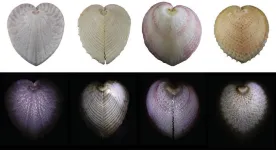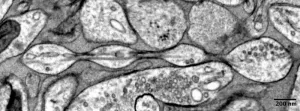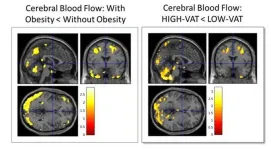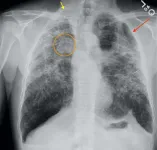(Press-News.org) DURHAM, N.C. -- Since the first fiber optic cables rolled out in the 1970s, they’ve become a major part of everything from medical devices to high-speed internet and cable TV. But as it turns out, one group of marine mollusks was way ahead of us.
A new study reveals that clams called heart cockles -– so-named because of their heart-shaped shells -- have unique structures in their shells that act like fiber optic cables to convey specific wavelengths of light into the bivalves’ tissues.
Researchers from Duke University and Stanford University used electron and laser microscopy and computer simulations of heart cockles to discover that their shells are designed with translucent areas consisting of hair-thin strands, arranged in bundles, that deliver light deep within.
The findings were published Nov. 19 in the journal Nature Communications.
Found in the warm, equatorial waters of the Indo-Pacific, heart cockles have a mutually beneficial relationship with microscopic algae that live inside their tissues. But algae need light to thrive.
While the algae get shelter and a safe place to live and grow, the clams benefit by feeding on the sugars the algae produce through photosynthesis.
To maintain this close bond, heart cockles have mastered the art of indoor gardening, directing light to their otherwise dark interiors.
They have evolved natural skylights to fuel the growth of their algal companions without opening their shells and exposing themselves to the beaks and claws of potential predators.
“They essentially evolved translucent windows in their shells,” said first author Dakota McCoy, who started this work as an NSF PRFB Fellow advised by Sönke Johnsen at Duke. McCoy has since become an assistant professor at the University of Chicago.
Using a laser scanning microscope to study the 3D geometry of heart cockle shells, the researchers discovered that beneath each window, tiny translucent bumps smaller than a grain of sand function as lenses, concentrating sunlight into a beam that penetrates into the clam’s interior where the algae reside.
“I imagine it like some organic cathedral with stained glass windows, with the light falling on the parishioners inside,” said Johnsen, the senior author and a biology professor at Duke.
The researchers got another surprise when they looked at the shells under a scanning electron microscope.
Heart cockles and many other marine animals use a special form of calcium carbonate called aragonite to make their shells. Under a microscope, most of the heart cockle’s shell has a layered structure, with thin plates of aragonite stacked in different orientations, “kind of like fancy brickwork,” McCoy said.
But within each window, the material of the shell forms tightly packed, hairlike fibers rather than plates, all lined up in the direction of incoming light.
“It looks just completely different than what you'd expect,” McCoy said.
Computer simulations showed that the size, shape and orientation of the fibers transmit more light into the heart cockles’ interior than other possible designs the creatures could have hypothetically come up with.
In particular, they let in light within the blue and red ranges -- the optimal wavelengths for photosynthesis -- but appear to block ultraviolet radiation from penetrating into their shells where it might otherwise damage their DNA.
“Together, the fibers and the lenses create a system for filtering out bad wavelengths, channeling in the good wavelengths, and focusing so that they go far enough into the shell, so that the algal symbionts get the best lighting environment possible,” Johnsen said.
The researchers also found that, because the bundled fibers in their shells are so tiny and packed together, if you shine a light through them, a high-resolution image of whatever is beneath appears on the other end, almost like a TV screen.
The team said more work is needed to understand what, if anything, the heart cockles are doing with this image projection superpower.
One day the clams could offer inspiration for new ways of designing fiber optic cables that allow light to travel great distances, even around curves, without escaping and losing signal along the way, Johnsen said.
“The shells do a very cool feat,” McCoy said.
This research was supported by grants from the National Science Foundation (2109465, 1933624 and ECCS-2026822).
CITATION: "Heart Cockle Shells Transmit Sunlight to Photosymbiotic Algae Using Bundled Fiber Optic Cables and Condensing Lenses," Dakota E. McCoy, Dale H. Burns, Elissa Klopfer, Liam K. Herndon, Babatunde Ogunlade, Jennifer A. Dionne & Sönke Johnsen. Nature Communications, Nov. 19, 2024. DOI: 10.1038/s41467-024-53110-x
END
To build better fiber optic cables, ask a clam
Heart cockles have shells with built-in skylights to let in light for symbiotic algae.
2024-12-02
ELSE PRESS RELEASES FROM THIS DATE:
Study may reverse century-old understanding of the shape of ‘arms’ on mammals’ brain cells
2024-12-02
**EMBARGOED FOR RELEASE UNTIL MONDAY, DEC. 2, AT 5 A.M.**
Biology textbooks may need a revision, say Johns Hopkins Medicine scientists, who present new evidence that an armlike structure of mammalian brain cells may be a different shape than scientists have assumed for more than a century.
Their study on mouse brain cells shows that the cells’ axons — the armlike structures that reach out and exchange information with other brain cells — are not the cylindrical tubes often pictured in books and on websites ...
Hidden fat predicts Alzheimer’s 20 years ahead of symptoms
2024-12-02
CHICAGO – Researchers have linked a specific type of body fat to the abnormal proteins in the brain that are hallmarks of Alzheimer’s disease up to 20 years before the earliest symptoms of dementia appear, according to a study being presented today at the annual meeting of the Radiological Society of North America (RSNA). The researchers emphasized that lifestyle modifications targeted at reducing this fat could influence the development of Alzheimer’s disease.
“This crucial result was discovered because we investigated Alzheimer’s disease pathology as ...
Countertop workers exposed to serious lung disease
2024-12-02
CHICAGO – Durable and attractive, engineered stone countertops are a popular feature in modern American kitchens, but the workers who build them are risking their health. A growing number of these countertop workers are developing silicosis, a serious and long-term lung disease, according to a study being presented today at the annual meeting of the Radiological Society of North America (RSNA).
“This is a new and emerging epidemic, and we must increase awareness of this disease process so we can avoid delays in diagnosis and treatment for our patients,” ...
Higher ratio of plant protein to animal protein may improve heart health
2024-12-02
Embargoed for release: Monday, December 2, 4:00 AM ET
Key points:
In a 30-year study of American adults’ diets, those who consumed the highest ratio of plant-based protein to animal-based protein had a 19% lower risk of cardiovascular disease (CVD) and a 27% lower risk of coronary heart disease (CHD) compared to those who consumed the lowest ratio.
According to the researchers, the findings suggest that a 1:2 ratio of plant to animal protein is effective in preventing CVD—and that an even higher ratio (1:1.3) may be needed to protect against CHD.
While global dietary guidelines recommend higher intake of plant ...
Lung cancer screening CTs find coronary artery disease in 83% of cases
2024-12-02
Lung cancer screening with low-dose chest computed tomography (CT) may detect more than just lung cancer. As new research in CMAJ (Canadian Medical Association Journal) https://www.cmaj.ca/lookup/doi/10.1503/cmaj.231602 shows, these CTs can identify coronary artery calcium, a strong risk factor for coronary artery disease (CAD), in patients without cardiac symptoms.
“Lung cancer screening, although primarily geared towards reducing deaths from lung cancer, also has an opportunity to help tackle the second ...
Consumers face barriers to embracing ethical fashion, psychologist warns
2024-12-02
Consumers are likely to continue making poor fashion choices unless eco-friendly choices become more accessible, according to a leading psychologist.
Carolyn Mair says brands must do more to promote sustainable clothing by making it more accessible to all, and by doing more to educate the public about mindful consumption.
Meaningful reforms to the current model of fashion production, in which garments are made from raw materials then discarded, have lagged, says Dr Mair who is also a fashion business consultant.
Making sustainable choices
In Dr Mair’s new book The Psychology of Fashion, she says eco-labels on garments are an important influence ...
Antiretroviral drugs for treatment and prevention of HIV in adults: 2024 recommendations of the International Antiviral Society–USA Panel
2024-12-01
About The Article: This narrative review from the International Antiviral Society–USA provides updated 2024 recommendations for HIV treatment and clinical management and HIV prevention. New approaches for treating and preventing HIV offer additional tools to help end the HIV epidemic, but achieving this goal depends on addressing disparities and inequities in access to care.
Corresponding Author: To contact the corresponding author, Rajesh T. Gandhi, MD email RGANDHI@mgh.harvard.edu.
To access the embargoed study: Visit our For The Media website at this link https://media.jamanetwork.com/
(doi:10.1001/jama.2024.24543)
Editor’s ...
Virginie McNamar appointed President and Chief Operating Officer (COO) of SynGAP Research Fund (SRF) dba Cure SYNGAP1
2024-12-01
Mill Valley, CA – December 1, 2024 – SynGAP Research Fund 501(c)(3), the leading patient advocacy group working to improve the lives of SYNGAP1-Related Disorders (SRD) patients, announces the appointment of Virginie McNamar as President and Chief Operating Officer, effective December 1, 2024.
“Virginie was a respected leader in the global SYNGAP1 community before SRF was founded. Her support and guidance in the early years was critical. Almost six years later, the SRF organization has grown to the point where a full time leader ...
Planetary boundaries: Confronting the global crisis of land degradation; Potsdam institute report opens UNCCD COP 16
2024-12-01
Riyadh, Saudi Arabia – A major new scientific report charts an urgent course correction for how the world grows food and uses land in order to avoid irretrievably compromising Earth’s capacity to support human and environmental wellbeing.
Produced under the leadership of Prof. Dr. Johan Rockström at the Potsdam Institute for Climate Impact Research (PIK) in collaboration with the UN Convention to Combat Desertification (UNCCD), the report is launched as nearly 200 UNCCD member states kick off their COP 16 summit ...
VUMC and Philips landmark emissions assessment of a radiology department published in premier industry journal
2024-12-01
A seminal cradle-to-grave analysis of hospital-based radiology services by the Department of Radiology at Vanderbilt University Medical Center and Royal Philips found the energy consumption from imaging equipment accounted for more than 50% of the department’s greenhouse gas emissions and shed light on areas to focus future evidence-based strategies to decarbonize.
The life cycle assessment (LCA) results, which have been peer-reviewed and published in Radiology, found diagnostic services generate the equivalent of nearly 1,100 gas-powered cars annually, or an estimated 4.6kt carbon dioxide equivalent.
Researchers ...
LAST 30 PRESS RELEASES:
Sports injuries sustained during your period might be more severe
World's first successful 2 Tbit/s free-space optical communication using small optical terminals mountable on satellites and HAPS
Can intimate relationships affect your heart? New study says ‘yes’
Scalable and healable gradient textiles for multi‑scenario radiative cooling via bicomponent blow spinning
Research shows informed traders never let a good climate crisis go to waste
Intelligent XGBoost framework enhances asphalt pavement skid resistance assessment
Dual-function biomaterials for postoperative osteosarcoma: Tumor suppression and bone regeneration
New framework reveals where transport emissions concentrate in Singapore
NTP-enhanced lattice oxygen activation in Ce-Co catalysts for low-temperature soot combustion
Synergistic interface engineering in Cu-Zn-Ce catalysts for efficient CO2 hydrogenation to methanol
COVID-19 leaves a lasting mark on the human brain
Scientists use ultrasound to soften and treat cancer tumors without damaging healthy tissue
Community swimming program for Black youth boosts skills, sense of belonging, study finds
Specific depressive symptoms in midlife linked to increased dementia risk
An ‘illuminating’ design sheds light on cholesterol
Who is more likely to get long COVID?
Study showcases resilience and rapid growth of “living rocks”
Naval Research Lab diver earns Office of Naval Research 2025 Sailor of the Year
New Mayo-led study establishes practical definition for rapidly progressive dementia
Fossil fuel industry’s “climate false solutions” reinforce its power and aggravate environmental injustice
Researchers reveal bias in a widely used measure of algorithm performance
Alcohol causes cancer. A study from IOCB Prague confirms damage to DNA and shows how cells defend against it
Hidden viruses in wastewater treatment may shape public health risks, study finds
Unlock the power of nature: how biomass can transform climate mitigation
Biochar reshapes hidden soil microbes that capture carbon dioxide in farmland
Reducing saturated fat intake shows mortality benefit, but only in high-risk individuals
Manta rays create mobile ecosystems, study finds
Study: Mixed results in using lipoic acid to treat progressive multiple sclerosis
Norbert Holtkamp appointed director of Fermi National Accelerator Laboratory
New agentic AI platform accelerates advanced optics design
[Press-News.org] To build better fiber optic cables, ask a clamHeart cockles have shells with built-in skylights to let in light for symbiotic algae.






